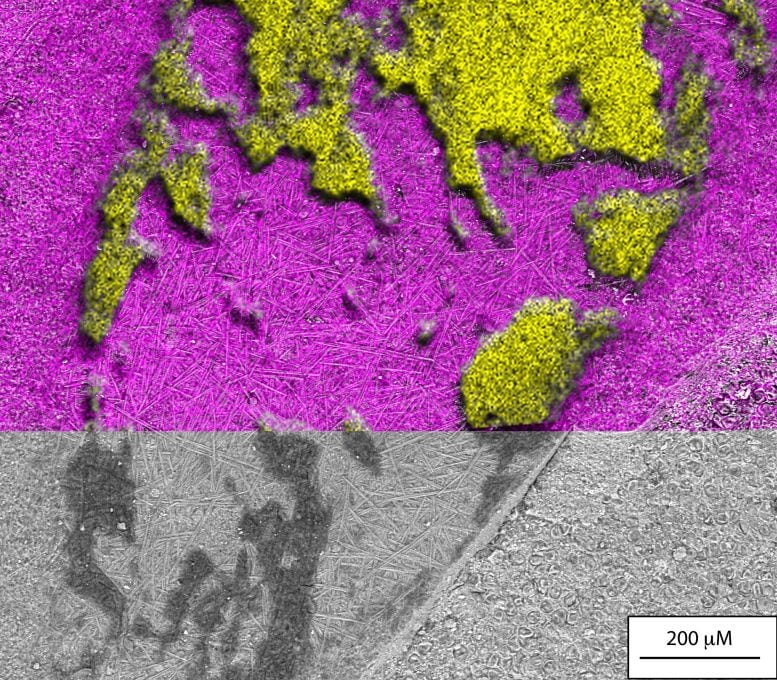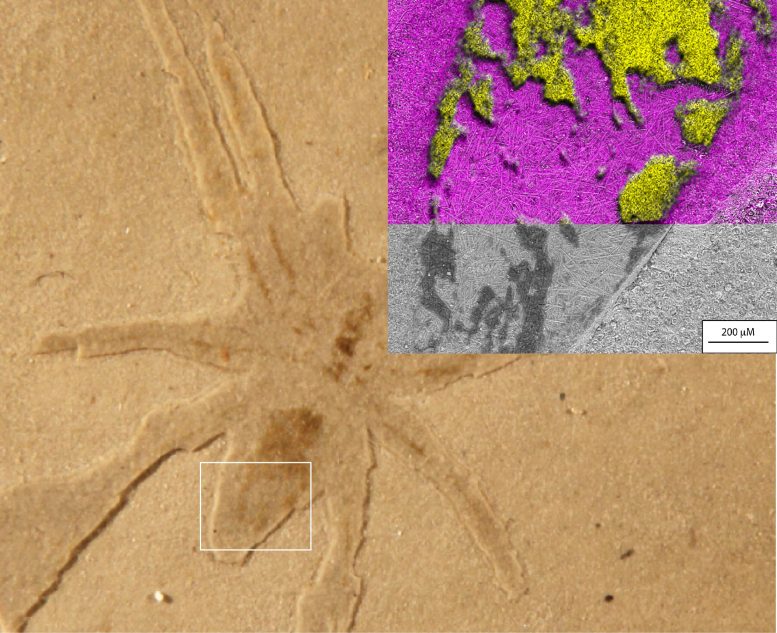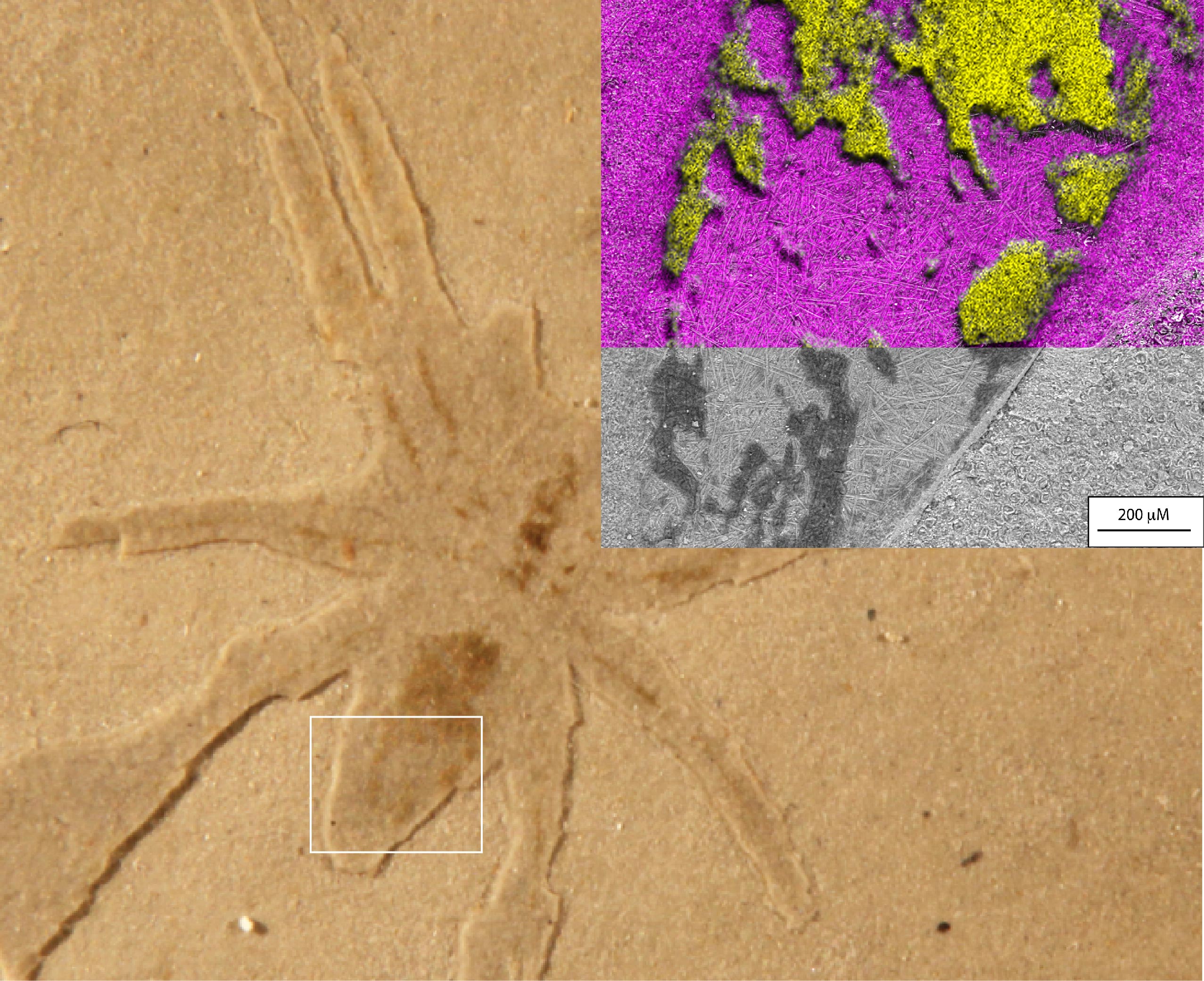Glowing spider fossils beckon groundbreaking research into a treasure trove of surprisingly well-preserved specimens
Fossilized spider from the Aix-en-Provence Formation in France seen in a hand sample overlaid with a fluorescent microscopy image of the same fossil. Under normal lighting, the spider fossil is difficult to differentiate from the surrounding rock matrix, but when the fossil is excited by UV illumination, its chemical composition causes it to autofluorescence, revealing further details about its preservation. Credit: Olcott et al.
Glowing spider fossils are prompting a groundbreaking study of how they were preserved in Aix-en-Provence.
A geological formation near Aix-en-Provence, France, is recognized as one of the world’s most important treasure troves of fossil species from the Cenozoic era. Scientists have discovered exceptionally well-preserved fossilized plants and animals there since the late 1700s.
“Most life forms do not become fossils.” — Alison Olcott
The Aix-en-Provence Formation is particularly famous for its fossilized terrestrial arthropods from the Oligocene period (about 23 to 34 million years ago). Because arthropods – animals with exoskeletons like spiders – are rarely fossilized, their abundance in Aix-en-Provence is staggering.
A new study published in the journal Earth & Environment Communications on April 21, 2022, researchers from the University of Kansas are the first to ask: what are the unique chemical and geological processes in Aix-en-Provence that preserve spiders from the Oligocene period so well?
“Most life forms don’t become fossils,” said lead author Alison Olcott, associate professor of geology and director of the Center for Undergraduate Research at KU. “It’s hard to become a fossil. You have to die under very specific circumstances, and one of the easiest ways to become a fossil is to have hard parts like bones, horns, and teeth. So our record of soft body life and terrestrial life, like spiders, is uneven – but we have these periods of exceptional preservation where all the circumstances were harmonious for preservation to occur.

Electronic scanning image of a fossilized spider abdomen revealing black polymer on the fossil and the presence of two types of microalgae: a mat of upright diatoms on the fossil and centered diatoms scattered in the surrounding matrix. This image is overlaid with sulfur (yellow) and silica (pink) chemical maps revealing that while the microalgae are siliceous, the polymer covering the fossil is sulfur-rich. Credit: Olcott et al.
Olcott and his KU co-authors Matthew Downen – then a doctoral candidate in the Department of Geology and now deputy director of the Center for Undergraduate Research – and Paul Selden, KU Distinguished Professor Emeritus, as well as James Schiffbauer of the University of Missouri, researched to uncover the exact processes in Aix-en-Provence that paved the way for the preservation of spider fossils.
“Matt was working on describing these fossils, and we decided – more or less on a whim – to stick them under the fluorescence microscope to see what happened,” Olcott said. “To our surprise, they were glowing, and so we were very interested in the chemistry of these fossils that made them glow. If you just look at the fossil on the rock, they’re almost indistinguishable from the rock itself, but they glowed a different color under the fluorescent bezel. So we started exploring the chemistry and discovered that the fossils themselves contain a black polymer made up of carbon and sulfur that under the microscope looks like the tar you see on the road. We also noticed that there were just thousands and thousands and thousands of microalgae all around the fossils and covering the fossils themselves.

Spider fossil from the Aix-en-Provence Formation with white box indicating location of scanning electron microscopy image and chemical map of sulfur (yellow) and silica (pink) seen top left . Together, these reveal a black, sulfur-rich polymer on the fossil and the presence of two types of siliceous microalgae: a mat of upright diatoms on the fossil and centered diatoms scattered in the surrounding matrix. Credit: Olcott et al.
Olcott and his colleagues hypothesize that the extracellular substance these microalgae, called diatoms, are known to produce may have shielded the spiders from oxygen and promoted spider sulphidation, a chemical change that would explain the preservation of fossils as carbon films over millions of years. following years.
“These microalgae form a sticky, slimy gloop – that’s how they stick together,” said the KU researcher. “I hypothesized that the chemistry of these microalgae, and the substance they were extruding, actually enabled this chemical reaction to preserve the spiders. Basically, the chemistry of the microalgae and the chemistry of the spiders work together so that this unique preservation to occur.
Indeed, this sulfurization phenomenon is the same as a common industrial treatment used to preserve rubber.
“Vulcanization is a natural process – we do it ourselves to harden the rubber in a well-known process,” Olcott said. “Sulfidation takes carbon and crosslinks it with sulfur and stabilizes the carbon, which is why we apply it to rubber to make it last longer. What happened chemically here, I think, is that the spider’s exoskeleton is chitin, which is made up of long polymers with carbon units close together, and it’s a perfect environment for sulfur bridges to come in and really stabilize things.
Olcott said the presence of diatomic mats could potentially serve as a guide to finding more well-preserved fossil beds in the future.
“The next step is to extend these techniques to other deposits to see if preservation is related to diatom mats,” she said. “Of all the other exceptional fossil preservation sites in the world in the Cenozoic era, about 80% of them are found in association with these microalgae. So we wonder if this explains most of these fossil sites that we have at this time – basically from shortly after the extinction of the dinosaurs until now. This mechanism could be responsible for giving us information to explore the evolution of insects and other post-dinosaur terrestrial life and for understand climate change because there is a period of rapid climate change and these terrestrial organisms help us to understand what happened to life the last time climate started to change.
Olcott and her colleagues are the first to analyze the chemistry of conservation in Aix-en-Provence, a fact she attributes in part to the challenges of doing the science during COVID-19[feminine] limitations.
“I honestly think this study is partly the result of pandemic science,” she said. “The first batch of these images appeared in May 2020. My lab was still closed; I was two months into my 18 month leg at home with kids all the time – so I had to change the way I do science. I spent a lot of time with these chemical images and maps and really explored them in a way that probably wouldn’t have happened if all the labs were open and we could have come in and done more conventional work.
Reference: “Exceptional preservation of Aix-en-Provence spider fossils could have been facilitated by diatoms” by Alison N. Olcott, Matthew R. Downen, James D. Schiffbauer and Paul A. Selden, April 21, 2022 , Earth & Environment Communications.
DOI: 10.1038/s43247-022-00424-7
The University of Kansas is a major research and teaching university. The university’s mission is to uplift students and society by developing leaders, building healthy communities, and making world-changing discoveries. The KU News Service is the central public relations office for Lawrence Campus.


Comments are closed.